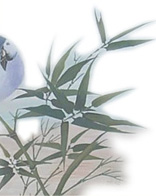|
|
 |
 |
| Chinese Folk Music The Moon Night of Spring River and Flowers
|
 |
 The Moon Night of Spring River and Flowers was Lute music at first, and was adopted into the folk orchestral music by Liu Yiaozhang and Zhengyan in Shanghai in 1925. The music describes and admires the charming landscape south of Yangtse River, just like a long picture scroll with many pieces of landscape paintings, accompanied by fascinating colors and sounds. The Moon Night of Spring River and Flowers was Lute music at first, and was adopted into the folk orchestral music by Liu Yiaozhang and Zhengyan in Shanghai in 1925. The music describes and admires the charming landscape south of Yangtse River, just like a long picture scroll with many pieces of landscape paintings, accompanied by fascinating colors and sounds.
> LISTEN TO The Moon Night of Spring River and Flowers
The music expresses the views from nine angles:
First of all, the sounds of the bell and the drum on the tower by the river: Lute simulates the sounds of drum from the tower by the river. Xiao and Cheng play out the sounds as water, to express the views of the sunset glow is upon the face of the river, and a warm southerly breeze is touching the lippers.
Continuing, the moon goes up the east of mountain slowly:  this is the main tune of the music, giving us a feeling that the moon is going up and up, then edges away. Just like making a picture, the music changes to express the poeple of water of the river. The music is down and down, then up and up, and the power of these changes strong. this is the main tune of the music, giving us a feeling that the moon is going up and up, then edges away. Just like making a picture, the music changes to express the poeple of water of the river. The music is down and down, then up and up, and the power of these changes strong.
Following, there are four very fast music sequences, from the quiet to rapid movement, describing the whirling wind and the returning water. The flowers are waving in the water. This part well expresses the nature views of the wind, water and flowers.
When the music enters the fifth part, the music is around in the bass area, then jumps up 8 degrees. The elegant sounds are played out so that we can feel the water vividly. The river and sky are the same color, and there is no dust in the sky, only the moon.
At this time, Xiao blows out a gently and melodious music piece, accompanied by the lute and wooden fish. Then the whole team plays together and the speed grows faster, just like the white sails, you could hear the songs of the fishermen from distant river. They are close but far away, then, the songs rise from all directions. In this part, the music is fast and impassioned, there is an art born of groups of the ships coming back and the great waves to beating against the bank.
The last two parts describe the sounds and the action of  rowing boats and and their oars, and you can feel the oars as they move in and out of the river, creating whirlpools one by one. rowing boats and and their oars, and you can feel the oars as they move in and out of the river, creating whirlpools one by one.
The volume rises, the pace is growing, the power and strength of the music is greater and greater as it progresses, finally reaching the peak.
The sounds of lute setting off the instrumental ensemble, the cantus is now rising, then deep and slow representing the ships as they disappear slowly ... all is quiet, the spring river sounds more peaceful. As the music ends, the lento and melodious rhythms are long-lasting.
The music is like a long picture, combining so many beautiful views together. The views are from quiet to active, from far away to near, expressing the loving nature of the musician. They are performed by taking the main tune of the music - repeat, variation, derivation, and by changing the dynamics and speed. They make the music beautiful and charming so it is welcomed and enjoyed in China and many other countries. I really hope you enjoy it as well.
Thank you for your reading and listening, any questions, comments and suggestions are welcomed.
--Shirley
|
|
|
|
| |
| |
|

